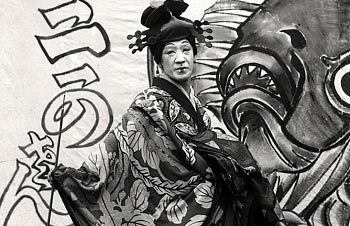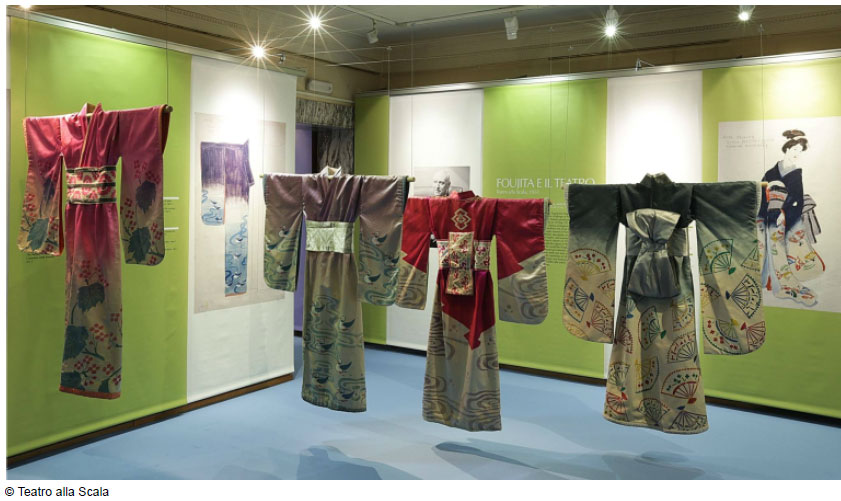
Foujita and the Performing arts
Foujita’s creation of theatrical costumes and sets is a little-known facet of the artist’s work. This aspect was rediscovered in autumn 2003 in Tokyo, where an exhibition organized in the new Prada building presented, for the first time in Japan, the costumes designed by Foujita for Giacomo Puccini’s opera Madame Butterfly.
The event was linked to the opera’s performance at the same time in Tokyo by artists from La Scala de Milan. The first performance of Madame Butterfly, set in Nagasaki during the Meiji era, took place in 1904 at La Scala in Milan. In 1955, when Maria Callas performed Madame Butterfly, Foujita was responsible for the sets, costumes and fabrics, which he dyed himself. For the blue and pink colors, he used a chemical dye that had just arrived from China in early 1950. Madame Butterfly wore stencil-dyed kimonos, some parts of which were hand-painted. The show was a great success, and was revived six times between 1952 and 1971. Also produced abroad, it was celebrated at the Vienna State Opera and the Lyric Opera of Chicago.
The Tokyo exhibition featured eleven extremely delicate costumes designed by Foujita, as well as the film of the performance shot in the 1950s. The detailed watercolors of the costumes and fabrics testify to the artist’s passion for the performing arts. A lover of materials, Foujita brought his precious meticulousness to the opera: each actor’s movement was followed by a slip of fabric to lighten their gait, and each accessory embellished their allure.
Foujita’s contributions to theater are manifold. Following in the footsteps of Picasso, who often collaborated with Serge Diaghilev on productions, sets and costumes for the Ballets Russes, Foujita was involved with the Compagnie des Ballets suédois, founded by Rolf de Maré and based at the Théâtre des Champs-Elysées from 1920 to 1925. Foujita directed and designed all the costumes and sets for one of these ballets, Le Tournoi singulier, created in 1924 under the direction of Rolf de Maré. Foujita’s costume and set designs for the Swedish Ballets were presented at the Musée d’Art Moderne in Paris in the exhibitions “Cinquantenaire des Ballets suédois: 1920-1925” in 1970-1971 and “L’Ecole de Paris, 1904-1929, la part de l’autre” in 2000-2001.

In 1928, Foujita worked on sets for a Japanese play by Firmin Gémier, Le Masque, presented at the Théâtre de l’Odéon. In Japan in the late 1940s, he also took part in several performances of Tchaikovsky’s Lac des cygnes.
From a more personal point of view, the show was an integral part of Foujita’s life: the artist staged himself, liked to dress up and dress eccentrically. During the Années Folles in France, he was eagerly received and celebrated, from the bals-costumés of Montparnasse to Deauville, accompanied by his friends Joséphine Baker and Mistinguett, stars of the music halls. Foujita cultivated his image as a festive, worldly dandy in the media, which he used in an avant-garde way to promote himself.




